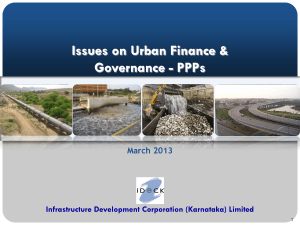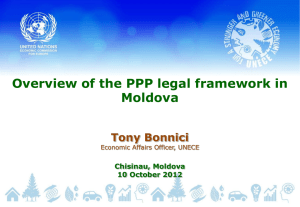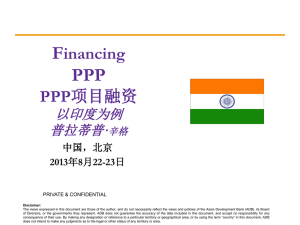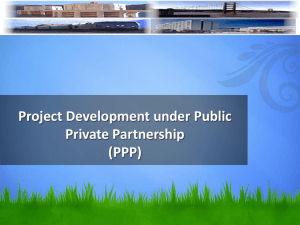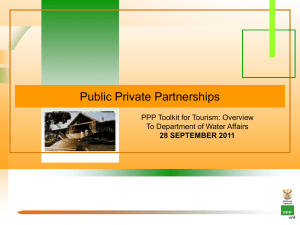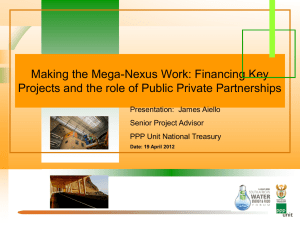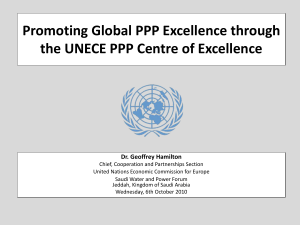Dep Minister Hon Proffesor Paul Mavima
advertisement
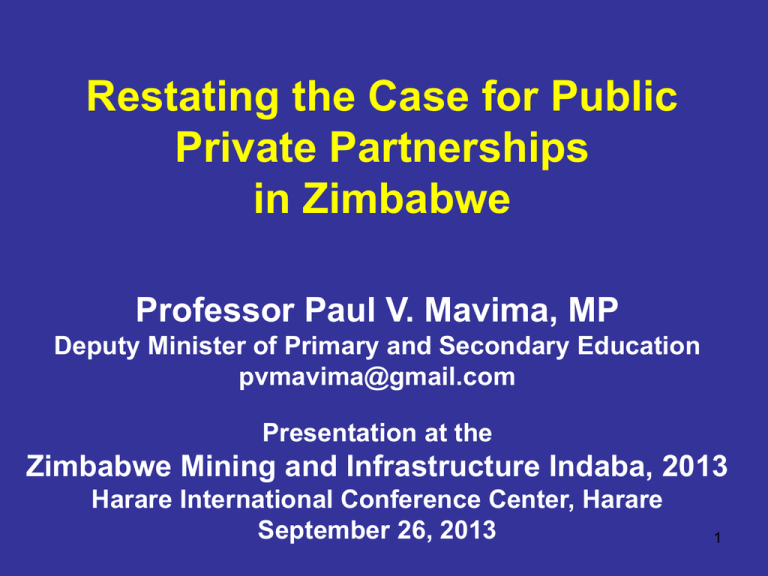
Restating the Case for Public Private Partnerships in Zimbabwe Professor Paul V. Mavima, MP Deputy Minister of Primary and Secondary Education pvmavima@gmail.com Presentation at the Zimbabwe Mining and Infrastructure Indaba, 2013 Harare International Conference Center, Harare September 26, 2013 1 Overview • The need for PPPs in Zimbabwe • The status of PPP legal and institutional framework • Way forward 2 The need for PPPs • Recovering lost ground • Inadequate supply of infrastructure facilities affects competitiveness (129 out of 139 in terms of GCI) • Inadequate public sector resources to rehabilitate and expand all infrastructure ($4.6 billion of private resources needed of a total $14.2billion) • Infrastructure bedrock for achieving MTP and realizing country’s overall aspirations 3 Comparative Quality of Infrastructure Namibia 26 Botswana 43 South Africa 46 Zimbabwe 79 Malawi 116 Zambia 118 Lesotho 122 Mozambique 126 0 20 40 60 80 100 120 140 Inadequate Spending on Maintenance Transport Routine Maintenance, 2009 Actual 15 6 3 Required 90 0 20 Roads 40 46 60 Rail 80 100 8 120 Civil aviation 140 160 Highlights of Sector Specific Infrastructural Needs • Electric power faces a 1,000 MW deficit to meet current demand • $ 4.3 billion needed to boost generation and other capacities in the electric power sector • $2.2 billion needed for water storage and transportation • $1 billion needed for the rehabilitation and improvement of sanitation facilities • $4.2 billion needed for the rehabilitation of road, rail and aviation infrastructure • Serious rehabilitation and expansion needs in social infrastructure 6 Historical Overview • 2004 PPP Guidelines – Promulgated by the Ministry of Finance – Provide general guidelines, but non-binding – Provided for institutions most of which remained nonfunctional • 2009 Capacity Building Workshop for PPPs for Economic Development – – – – Review state of uptake Review international best practice Reenergize the country around the concept Recommended a revamp of the existing guidelines and development of a PPP enabling framework 7 UNDP Funded Framework Review • Legislative Review – Recommended making PPP regulations under a particular Act • Draft PPP Policy – Rationale, institutional framework, roles and responsibilities and approval process • Draft PPP Institutional Framework – Responsible authorities, Inter-ministerial committee on PPPs, PPP Unit, Ministry of Finance, Cabinet and its Committees • Draft PPP Guidelines – Project identification, feasibility, prequalification, bidding negotiation and contract management 8 Overview of Recommended Process 9 Highlights of the Legislative Principles • Ministries identify and submit proposals of Projects to PPP Unit, participate in selection process and manage contracts • Treasury approves budget and commits funds for the project at start of procurement • PPP Unit – Body corporate warehouses expertise on PPPs and advices ministries throughout the PPP process • PPP Function location potentially split between Treasury and the Presidency • OPC responsible for championing while Treasury supervises the deal making 10 Way Forward • Establish a PPP Task force within the Office of the President and Cabinet (operate synergistically with SERA) • Pass the PPP Bill during the current session of Parliament • Align the Policy Document and Guidelines to the Act • Launch the Policy and the Guidelines • Convert PPP Task Force into PPP Unit • Actively participate in regional PPP networks (SADC PPP Network, AP3Network) and global events (PPP Days) • Tap into expertise provided through specialist bodies within international development agencies (PPIAF, UNECE International Centre for PPP Excellence, the 3P Institute in Washington DC). 11 Thank you! Questions and Discussion 12




